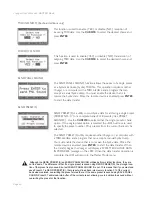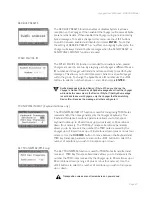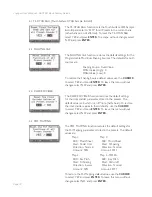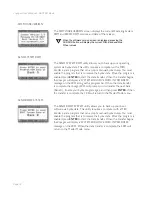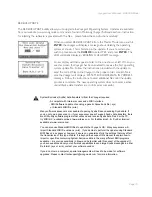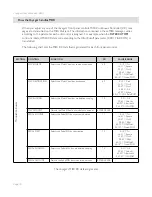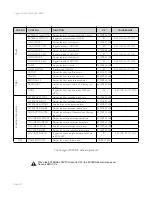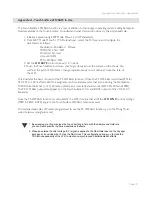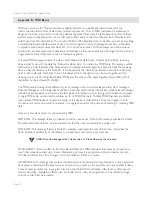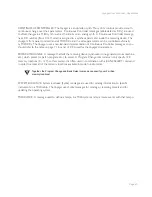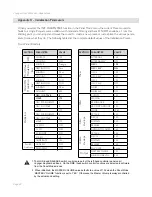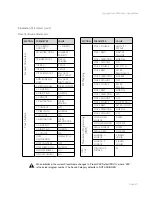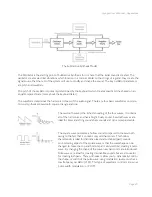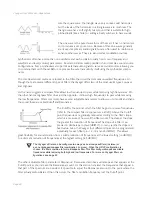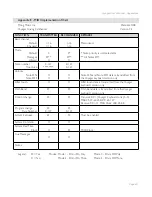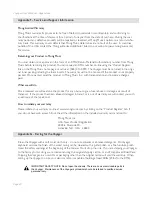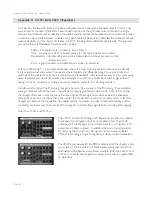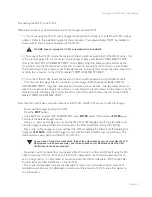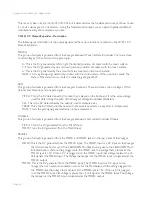
Page 80
Voyager User’s Manual - Appendices
Page 81
Voyager User’s Manual - Appendices
MIDI is an acronym for ‘Musical Instrument Digital Interface’, an industry-standard protocol for the
interconnection and control of electronic musical instruments. Prior to MIDI, instrument manufacturers
designed their own systems for connecting devices together (most were CV/gate based), but few of these
systems were compatible, which meant that you couldn’t easily connect synthesizers from Manufacturer A
with those from Manufacturer B. The arrival of MIDI in 1983 simplified the connection process by providing
a standard hardware interface and a series of common digital command messages that allow synthesizers,
computers, sound cards, drum machines, etc., to control one another. MIDI messages can define musical
events, such as notes played, note duration and loudness, or they can specify the exchange of data, such as a
single preset, a bank of presets, or even a firmware upgrade.
A typical MIDI message consists of a status byte followed by data bytes. A status byte tells the receiving
device what to do with the data that follow the status byte. For instance, a MIDI Note On message will be
followed by a byte that states the Note value to be played, followed again by a byte that tells the receiving
device what the Velocity of the Note On is (on keyboards, the ‘Velocity’ parameter is associated with how
hard a note is played). Data bytes have 7-bit values (0-127), though two can be sent together, and by
defining one as the Most Significant Byte (MSB), and the other as the Least Significant Byte (LSB), 14-bit
resolution can be achieved (0-16383).
The MIDI standard categorizes different types of messages into channel messages and system messages.
Channel Messages are for things like Note Ons, and other performance information, while System Messages
include System Exclusive commands and other global information, such as timing synchronization messages.
A single MIDI cable can be used to address up to 16 MIDI Channels. Multiple MIDI Channels are helpful
when several MIDI devices are used in a setup, or if a device is multi-timbral. Since the Voyager is both
monophonic and mono-timbral, it operates on a single channel for the purpose of sending or receiving MIDI
data.
Here are a few basic terms for understanding MIDI:
NOTE ON: This message tells a synthesizer to start a note event. A Note On message specifies the Note
Number and Attack Velocity (on a keyboard, how fast the note is pressed) for a single note.
NOTE OFF: This message follows a Note On message and signals the end of that note. It specifies the
Note Number and Velocity of the release (on a keyboard, how fast the key is let up).
PITCH BEND: Tied most often to the Pitch Bend Wheel of a MIDI keyboard, this message conveys how
much that wheel is pushed up or down. Depending on how it is programmed, the synthesizer can turn
Pitch Bend information into a change in pitch, modulation, timbre or volume.
AFTERTOUCH: A message that contains information about keyboard pressure sensitivity. Some keyboards
have sensors underneath the keys to sense how much you press on the key after you have pushed it down.
These sensors generate the raw signals that are turned into Aftertouch Data. Aftertouch is often used is
selectly introduce modulation effects such as vibrato, but can also be programmed to bend pitch, change
volume or alter filter parameters.
Appendix B - MIDI Basics
A MIDI Note On message with a Velocity value of ‘0’ is another way to end a note.

